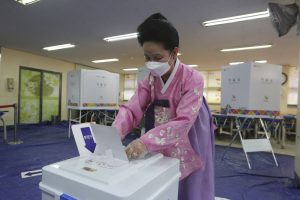South Korea’s ruling liberal party secured a resounding victory in parliamentary elections that had the highest turnout in nearly three decades, despite the coronavirus forcing social distancing at polling places.
The ruling Democratic Party and a satellite party it created to win proportional representative seats combined to win 180 seats in the 300-seat National Assembly, election officials said Thursday. Conservatives suffered their worst showing in the densely populated Seoul metropolitan area in years.
The comfortable majority will likely embolden President Moon Jae-in’s government to pursue its key domestic and foreign objectives, such as reviving diplomacy with nuclear-armed rival North Korea, while it grapples with the pandemic that is shuttering businesses and threatening livelihoods.
Moon thanked the country’s “great people” for “giving strength to a government that’s fighting desperately to overcome a national crisis.”
More than 17 million South Koreans voted on Wednesday. When combined with the 11.8 million early and mailed-in votes, turnout was 66.2 percent, the highest since 71.9 percent turnout in a 1992 general election, the National Election Commission said.
The voting drew sharp contrasts with upended election cycles in the United States and Europe and possibly set an example for how democratic elections can be handled during the pandemic.
Health officials described the election as a crucial experiment as they discuss more sustainable forms of social distancing that allow for some communal and economic activity while containing the risk of infection. But they acknowledged it would take at least a week to assess the election’s impact on the epidemic.
While South Korea is just three years removed from mass protests that led to the ouster of Moon’s corrupt conservative predecessor, public displays of the country’s dynamic democracy were largely muted this year as candidates, wearing masks and gloves, avoided large rallies and handshakes.
Before the virus began absorbing public attention, Moon’s support was faltering over a decaying job market, corruption scandals surrounding key political allies, and troubled ties with North Korea.
But surveys ahead of the polls indicated growing support for his government, reflecting public approval of an aggressive test-and-quarantine program credited with lowering fatality rates compared to China and some places in Europe and North America. As of Thursday, South Korea reported more than 10,600 people infected with 229 confirmed deaths.
South Korea’s electorate is deeply split along ideological and generational lines and regional loyalties. But surveys since infections surged in late February showed swing voters in their 20s and 50s expressing stronger willingness to vote, said Jeong Han-wool from Hankook Research, an opinion-research firm in Seoul.
Park Sung-min, president of Seoul-based MIN Consulting, a political consulting firm, said a sense of urgency over the coronavirus drove more people to the polls. He said the conservatives failed to establish themselves as a viable alternative, squabbling internally over agendas and candidate selections.
Hwang Kyo-ahn, who led the conservative United Future Party, stepped down as chairman after losing in a key Seoul district to Democratic Party candidate Lee Nak-yeon, a former prime minister who emerged as a front-runner for the 2022 presidential race. Hwang, also an ex-prime minister, apologized to supporters for “failing to prevent the country from going in the wrong direction at an important time.”
The massive loss will raise new questions about the South Korean right’s ability to rebuild after the impeachment of Park Geun-hye, the previous conservative president.
South Korean election and health officials prepared safeguards to reduce the risk of the virus being spread during the voting.
Masks were worn by voters and poll workers. A meter (3 feet) of social distancing space was marked from nearby streets all the way to the ballot booths. Voters who passed a fever screening were given sanitizing gel and disposable plastic gloves before entering booths. Anyone with a fever was whisked to a separate area to vote.
More than 11,150 people formally quarantined in their homes were escorted or monitored through tracking apps while they cast their ballots later than other voters. Workers dressed in full protective suits sanitized the booths after each vote. Those hospitalized or in isolation or quarantine could vote by mail or at temporary shelters during early voting last week.
The controls weren’t perfect. Park Jong-hyun, an official from the Ministry of the Interior and Safety, said at least six quarantined voters wandered around after leaving home to cast their ballots. Officials planned to bring charges against at least one of them who visited a billiard club and a computer gaming room.
By Kim Tong-Hyung for The Associated Press.

































